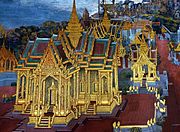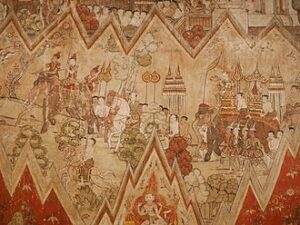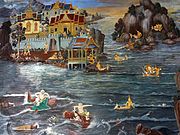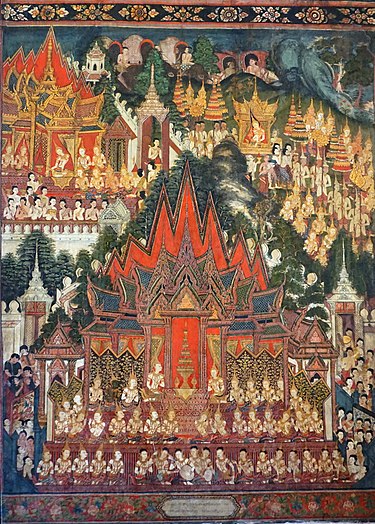Traditional Thai painting is an ancient art form that has been passed down through generations in Thailand. The art form evolved through the Sukhothai, Ayutthaya, and Rattanakosin periods, with each era contributing unique elements to the style. The paintings typically feature flat images with lines as the main boundaries, and use secondary elements such as trees, mountains, streams, and rocks as dividing events or areas of the image. The use of color is flat paint and does not show shadows. Natural colors derived from earth elements, minerals, rocks, metals, plants, and some parts of animals are used in traditional Thai painting. The colors are often monochromatic, but there are also five-color variations called benjarong.


During the Sukhothai and Ayutthaya periods, traditional Thai painting evolved and was influenced by elements of the culture, including monochromatic and various colors. The paintings were found at various locations such as the ubosot, prang, viharn, sermon hall, ho trai, kuti, dharma cabinet, samut khoi, and phra bat. Ayutthaya period has more surviving examples of paintings, with many found in the form of murals on temple walls featuring Buddhism-related subjects such as history of the Buddha, Mahanipata Jataka, and Thep Chumnum.
In the Rattanakosin period traditional Thai painting was inspired by the events of the country, life, society, traditions, costumes, houses, temples, castles, palaces, nature, and various animals. Portraits and architecture stand out in groups, using strong colors and strongly contrasting opposite colors. The contrasting colors are balanced and harmonized. The composition of the picture often features the Tri Bhum image behind the principal Buddha image and a picture telling the story of the Lord Buddha and the Jataka tales on the side. Traditional Thai painting from this period is characterized by a heavy dark background and a heavy use of gold leaf.

From the end of the reign of King Rama III, the influence of Western painting began to flow into Thailand. This resulted in a modification of traditional Thai painting styles in various Buddhist places. The original flat images were transformed into deep, three-dimensional images that look more realistic, influenced by the Western style of painting. An important painter during the reign of King Rama IV was Khrua In Khong. He was one of the first Thai painters to experiment with the Western style of painting while maintaining the traditional Thai art form.
Many of the images in traditional Thai painting tell stories of the Lord Buddha, the Jataka tales, or important events in Thai history. The paintings often feature intricate details and designs that are specific to Thai culture, such as the traditional Thai costumes and architecture. Traditional Thai painting is still practiced today, with modern artists combining the traditional art form with contemporary techniques and styles.

